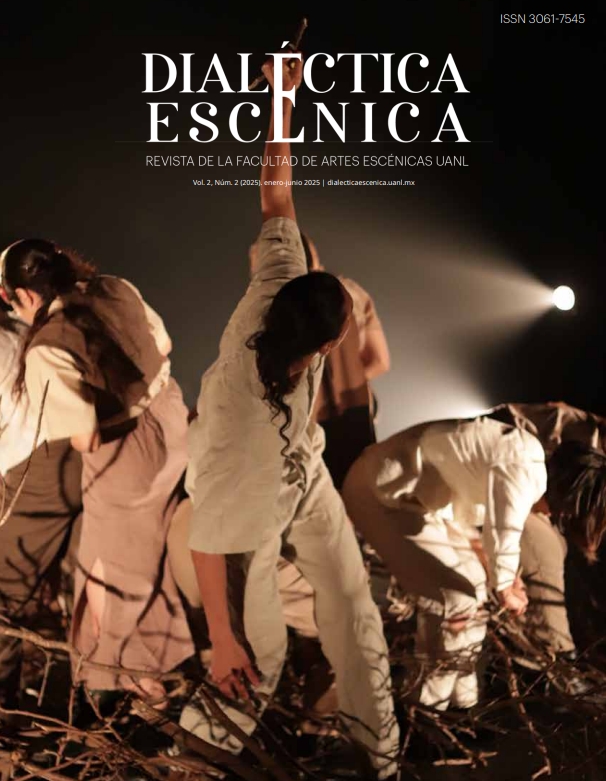The Actor and Play
Contributions of Play and Sports Theories to a Performative Perspective on Acting Work
DOI:
https://doi.org/10.29105/de.v2i2.15Keywords:
Game theory, sports, performance, Actor, rehearsalAbstract
Based on the playful connotation of the actor's work found in numerous languages, this article proposes exploring concepts and methodologies from game theory to renew our perspective on acting. Drawing from anthropologists who study play and contributions from sports theories, we present theoretical and practical resources to justify a critical reevaluation of the iterative and recurring nature of acting work and to explore what the actor’s craft could gain by embracing it as pure game.
References
Barba, E. et Savarese, N. (1990/2008). L’Energie qui danse. L’art secret de l’acteur, un dictionnaire d’anthropologie théâtrale. Ed. L’Entretemps.
Berger, L. (16 de marzo de 2021). Medida X medida à partir de W. Shakespeare, adaptation et mise en escène Laurent Berger [Video]. Youtube. https://www.youtube.com/watch?v=JwYASbPYnRg
Berger, L. (28 de marzo de 2021). D. Quixote, 2017 Complet. [Video]. Youtube. https://www.youtube.com/watch?v=FLxIGrFBrhI
Berger, L. et al. (2022). Entrevista a Claire Deutsch [Base de datos del proyecto Etre et jouer, financiado por el FNS Suizo]. BDD E & J. La Manufacture Lausane. (material inédito).
Berthoz, A., Andrieu, B. (2010). Le Corps en acte, centenaire Maurice Merleau-Ponty. Ed. Presses Universitaires de Nancy.
Caillois, R. (1958/1992). Les jeux et les hommes. Ed. Gallimard.
Damborg, T. (2020). How might Embodied Cognition, Contact Improvisation and Meisner’s Standard Repetition Exercise together illuminate actor movement training? Theatre, Dance and Performance Training, 11(1), 49-59. https://doi.org/10.1080/19443927.2019.1616322 DOI: https://doi.org/10.1080/19443927.2019.1616322
Descola, P. (2022). Le sport est-il un jeu? Ed. Robert Laffont.
Donellan, D. (2004). L’Acteur et la cible: Règles et outils pour le jeu. Ed. L’Entretemps.
Dusigne, J.F. (2008). L'acteur naissant: la passion du jeu. Ed. Théâtrales, Futuroscope, SCÉRÉN-CNDP, Montreuil-sous-bois.
Famose, J. P. (1993). Cognition et performance. INSEP-Éditions. http://books.openedition.org/insep/1399 DOI: https://doi.org/10.4000/books.insep.1399
Etchells, T. (2002). Certain fragments: Contemporary performance and Forced Entertainement. Ed. Routledge. DOI: https://doi.org/10.4324/9780203449639
Etchells, T. (s. f.). Entrevista para Real Magic, de Forced Entertainement [Programa de la temporada 17-18]. humain TROP humain (hTh)-CDN, p. 4.
Fischer-Lichte, E. (2004). Ästhetik des Performativen. Ed. Suhrkamp.
Gob Squad. (2016). Entrevista a Gob Squad para Western Society [Programa de Temporada 16-17]. humain TROP humain (hTh)-CDN. p. 109.
Goudard, P. (2010). Le Cirque entre l’élan et la chute: une esthétique du risque. Ed. Espace 34.
Grotowski, J. (1968). Vers un théâtre pauvre. Ed. L’Age d’Homme.
Hamayon, R. (2012). Jouer, Une étude anthropologique. Ed. La découverte.
Huizinga, J. (1972). Homo Ludens. Ed. Gallimard.
Jouen, F. & Molina, M. (2007). Naissance et connaissance: La cognition néonatale. Coll. PSY-Théories, débats, synthèses Ed. Mardaga. DOI: https://doi.org/10.14375/NP.9782870099681
Lecoq, J. (1997). Le Corps Poétique: Un enseignement de la création théâtrale. J.G. Carasso, & J.C. Lallias (Colab.). Ed. Actes Sud - Papiers / ANRAT.
Mnouchkine, A. (1993). Le Théâtre est oriental [Propos recueillis]. In Confluences-Le dialogue des cultures dans les spectacles contemporains. Saint-Cyr l’École, Prépublication, Le petit bricoleur.
Oida, Y. (1992). L’Acteur Flottant, M. Million [Trad]. Actes Sud / Académie Expérimentale des Théâtres.
Pavis, P. (2018). Dictionnaire de la performance et du théâtre contemporain. Ed. A. Colin. DOI: https://doi.org/10.3917/arco.pavis.2018.01
Recopé, M. & Fache, H. (2010). La sensibilité incorporée des volleyeurs les plus “actifs”. In A. Berthoz (Ed.), Le Corps en acte: Centenaire Maurice Merleau-Ponty (p. 285). Ed. Presses Universitaires de Nancy.
Roy, B. (2019). Pour un dépassement des théories du game et du play. Sciences du jeu, (11). https://doi.org/10.4000/sdj.1709 DOI: https://doi.org/10.4000/sdj.1709
Shusterman, R. (2010). Le corps en acte et en conscience. In A. Berthoz (Ed.), Le Corps en acte: Centenaire Maurice Merleau-Ponty (p. 207). Ed. Presses Universitaires de Nancy.
Vitez, A. (1985). “Une entente”, propos recueillis par André Curmi. Théâtre/Public, (64/65), p. 27.
Zeami, L. (1960). Tradition secrète du Nô. R. Sieffert [Trad.]. Ed. Gallimard.
Downloads
Published
How to Cite
Issue
Section
License
Copyright (c) 2025 Laurent Berger

This work is licensed under a Creative Commons Attribution 4.0 International License.





